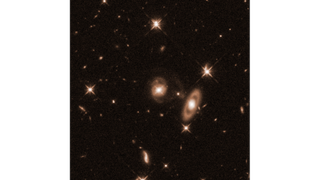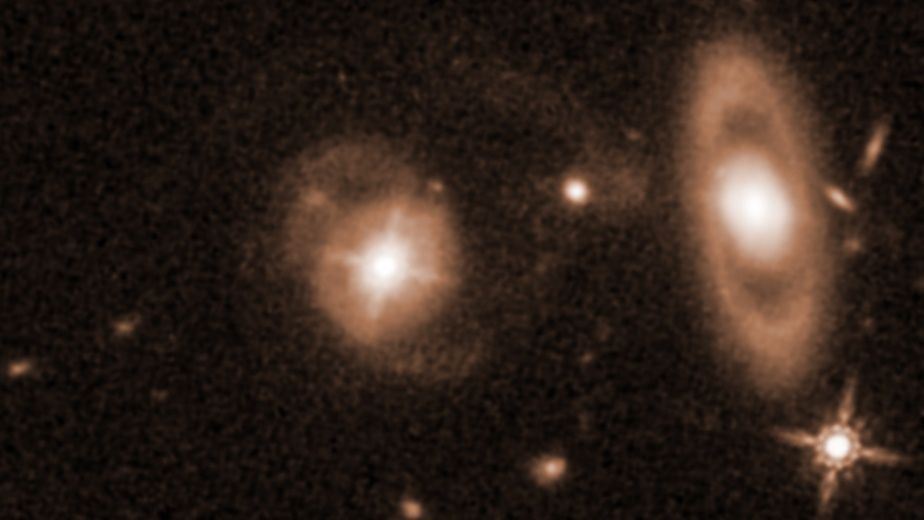The Hubble Space Telescope image you see above is from last year, and it showcases several galaxies that inhabit a pocket of our universe roughly 5.94 billion light-years away from us. Astronomers, however, have been particularly intrigued by what isn't visible in the image, but rather only "seen" through radio emissions.
Blasting from the central galaxy — home to a black hole more than 400 million times our sun — is a powerful jet that could provide fresh clues about how galaxies and their black holes evolve in tandem over eons. First, however, we need to figure out where this jet in the Hubble Telescope image came from in the first place.
Jets like these are known to erupt from elliptical galaxies that have been sculpted through chaotic mergers with other galaxies — such mergers are the key to funneling gas and dust toward gargantuan black holes lurking at the centers of galaxies and fueling the jets even further. But astronomers scrutinizing this particular Hubble image found the central galaxy actually sports a swirl of spiral arms seemingly unruffled by any such merger, raising new questions about what might have triggered its jet.
"At first, I thought I completely messed up during our research," Olivia Achenbach of the United States Naval Academy told reporters on Monday (Jan. 13) at the 245th meeting of the American Astronomical Society in Maryland. "Because it's such a large supermassive black hole at the center, we'd predicted we'd see an elliptical galaxy."
The spiral host galaxy, a quasar named J0742+2704, was discovered emanating a "newborn" jet in 2020 in new and archival radio surveys, which recorded radio emissions that revealed the jet had "switched on" within just two decades.
Pinning down the physics of these galactic jets is of interest not only to astronomers, who use radio observations of thousands of quasars to populate the celestial grid that guides telescope pointing, but also to the U.S. Navy, which relies on the cosmic lighthouses as navigational beacons in GPS-constrained environments. Newfound quasars like J0742+2704 serve as additional reference points in these systems, and studying their jets — which can significantly offset the positions of quasars when viewed from Earth — can help researchers better understand and eventually predict their elusive nature.
"We don't really understand the physics of these quasars of their jets," Achenbach said during the briefing. "It's really important to understand this physics to maintain navigation systems."

While the spiral shape of J0742+2704 suggests it hasn't undergone any major mergers, the HST image reveals faint indications that its lower arm has been disrupted, possibly due to the tidal forces from interactions with the large galaxy to the lower right. This may suggest that jets can also be triggered by less dramatic interactions between galaxies, rather than requiring a full merger.
"Clearly there is something interesting going on," astronomer Kristina Nyland of the Naval Research Laboratory, who was Achenbach's adviser on this research, said in a statement. The large galaxy appears to be a ring galaxy, another telltale sign of bygone interactions, as such galaxies often form when a smaller galaxy passes through the center of a larger one, disrupting its gas and dust. "We may be witnessing the aftermath of the interaction that triggered this young quasar jet," said Nyland.
Forthcoming observations of this system that will seek to confirm the distances of these galaxies would more conclusively determine the nuances of their "cosmic dance," according to Achenbach.
"If we looked at this galaxy 20 years, or maybe even a decade ago, we would have seen a fairly average quasar and never known it would eventually be home to newborn jets," she said in the same statement. "It goes to show that if you keep searching, you can find something remarkable that you never expected, and it can send you in a whole new direction of discovery."

.jpg) 12 hours ago
1
12 hours ago
1

 English (US)
English (US)